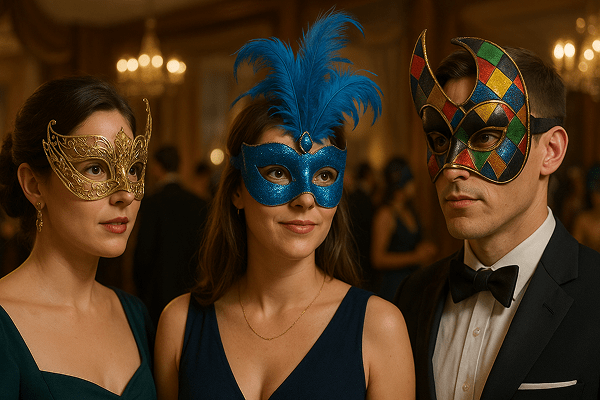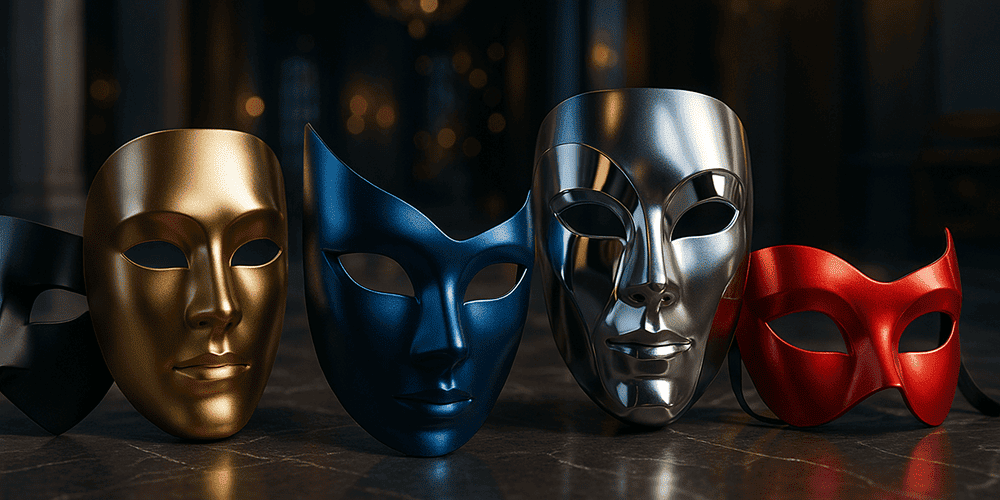Modern Masquerade Masks are a vibrant evolution of the historic masks that once graced the grand balls and carnivals of Europe. Today’s masks retain the allure of anonymity and transformation but are distinguished by bold innovations in design, materials, and artistic intent. These masks may feature sleek geometric forms, avant-garde embellishments, minimalist or futuristic motifs, and an array of unconventional materials. While often referencing their Venetian or Baroque origins, modern masquerade masks are just as likely to incorporate influences from global pop culture, contemporary fashion, or digital art. They are worn at themed parties, fashion events, festivals, weddings, and theatrical performances worldwide, reflecting both individual creativity and a cosmopolitan aesthetic. For more on the imaginative side of masking, see also Fantasy Masks, which push the boundaries even further.
Historical Origins of Modern Masquerade Masks
The story of modern masquerade masks is deeply connected to the tradition of masking in Renaissance and Baroque Europe, especially in Venice, where masked balls (mascherata) allowed people to transcend social boundaries and indulge in playful or subversive behavior. The word “masquerade” comes from the Italian “maschera,” meaning mask. Over time, the mask evolved from a simple visor to an ornate work of art, with the 18th-century Venetian mask-makers’ guild establishing high standards of craftsmanship.
The 20th and 21st centuries saw the transformation of masquerade masks as artists, designers, and performers began reinterpreting traditional forms through the lens of modern art, pop culture, and new technology. The spread of global communication, the influence of cinema and fashion, and the rise of themed parties led to a renaissance of mask-wearing, with innovations in both style and function. Notable moments include the use of masks in Art Deco and Surrealist movements, their presence in Hollywood films, and the explosion of creative mask design during the contemporary festival boom.
Cultural Significance and Symbolism of Modern Masquerade Masks
Modern Masquerade Masks carry rich layers of symbolism. In today’s culture, they continue to represent transformation, liberation, and the playful suspension of identity. Masks worn at modern balls and parties allow participants to step outside everyday roles, explore hidden aspects of themselves, and connect with others in new ways.
Socially, modern masks reflect values of inclusivity, diversity, and self-expression. They are used to celebrate individuality as well as collective creativity, providing a space for experimentation and social commentary. In some contexts, masks even serve as political or artistic statements, critiquing social norms or highlighting cultural issues. Myths and legends persist, with designers drawing inspiration from fairy tales, fantasy, and world folklore to imbue masks with deeper meaning.

Materials and Crafting Techniques of Modern Masquerade Masks
Modern masquerade masks showcase a vast range of materials and techniques:
- Traditional materials: Papier-mâché, leather, ceramics, and metal.
- Contemporary materials: Acrylic, resin, 3D-printed polymers, upcycled plastics, and smart fabrics.
- Decorative techniques: Hand-painting, airbrushing, laser-cutting, embroidery, digital printing, LED lighting, and metallic leaf application.
- Embellishments: Crystals, sequins, feathers, ribbons, wire, beads, and even augmented reality elements.
The process may begin with digital design or hand-drawn sketches, moving to sculpting, molding, or CNC cutting. Regional differences are evident: European masks often reference classic forms with a modern twist, while Asian and American designers might favor pop art, manga, or streetwear influences. Color symbolism is used both traditionally and innovatively — metallics for luxury, neons for futurism, black and white for minimalism, and rainbow hues for inclusivity.
For artisan stories and workshops on contemporary mask-making, see tutorials and interviews at toddmasks.com.
Functions and Uses of Modern Masquerade Masks
Modern masquerade masks are used in a wide array of settings:
- Ritual and ceremonial use: Sometimes featured in modern weddings, coming-of-age events, and themed ceremonies.
- Theatrical application: Essential in avant-garde theater, dance, and performance art.
- Festivals and holidays: Popular at contemporary masquerade balls, fashion galas, New Year’s Eve parties, and global festivals.
- Art and fashion: Worn at runway shows, art installations, and editorial photo shoots.
- Contemporary use: Integrated into digital events, virtual parties, or augmented reality experiences.
The function of the mask has evolved from strict ritual and social inversion to encompass entertainment, art, protest, and digital self-expression.
Regional Variations of Modern Masquerade Masks
Modern masquerade masks reflect global diversity:
- Europe: Designers reinterpret Venetian, Baroque, and Rococo styles with modern minimalism or maximalist embellishments.
- United States: Pop culture, comic books, and cinema inspire bold, playful designs.
- Asia: Masks may blend manga, K-pop, cyberpunk, and traditional motifs.
- Africa and Latin America: Contemporary artists fuse ancestral techniques with urban art and eco-conscious materials.
Each region brings unique techniques, materials, and cultural references, making modern masquerade masks a vibrant tapestry of global creativity.
Famous Examples and Notable Collections of Modern Masquerade Masks
Modern masquerade masks are featured in museums, galleries, and private collections around the world:
- Victoria and Albert Museum (London): Contemporary and historic mask exhibitions.
- Venice Biennale: Cutting-edge art masks and installations.
- Fashion houses: Limited-edition masks by designers such as Alexander McQueen, Dior, and Maison Margiela.
- Private collections: Artist-signed masks, masks worn at notable galas and balls, and masks featured in films or performances.
Online galleries and expert commentary can be found at toddmasks.com, highlighting both avant-garde and classic modern mask designs.

Influence of Modern Masquerade Masks on Art and Culture
Modern masquerade masks have a strong presence in visual art, theater, dance, literature, cinema, and fashion. Their forms inspire painters, sculptors, choreographers, and costume designers. In film and literature, masks embody themes of hidden identity, transformation, and social commentary.
Fashion designers incorporate mask motifs in collections and runway events, while musicians and performance artists use masks to craft stage identities. The mask’s adaptability makes it a symbol of both tradition and innovation in contemporary culture, ensuring its continued relevance.
Contemporary Status and Preservation of the Modern Masquerade Mask Tradition
Today, the tradition of making and wearing masquerade masks is thriving. Master artisans, independent designers, and digital artists push the boundaries of mask-making, blending traditional craft with 3D printing, smart textiles, and interactive elements. Schools, museums, and online platforms like toddmasks.com offer workshops, exhibitions, and educational programs for all ages.
Modern adaptations include eco-friendly materials, modular designs, and collaborations between artists, technologists, and fashion houses. Annual balls, festivals, and themed events keep the tradition alive, while virtual reality and social media open new frontiers for mask artistry.
Collecting and Acquiring Modern Masquerade Masks
The market for modern masquerade masks is dynamic, ranging from affordable artisan works to high-end, artist-signed or couture pieces. Authentic masks can be found at galleries, fashion boutiques, museum shops, and reputable online platforms like toddmasks.com. Price is influenced by:
- Material and craftsmanship
- Artistic reputation
- Provenance and documentation
- Innovation and uniqueness
Collectors should support living artists, seek quality and originality, and consider ethical and environmental factors when acquiring masks.
